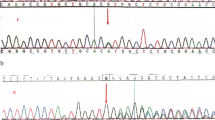Summary
Glucosephosphate isomerase deficiency as the cause of macrocytic congenital nonspherocytic hemolytic anemia is described in three unrelated families. The biochemical properties of the variant glucosephosphate isomerases indicate that the patients have new variants, designated as GPI Kiel, GPI Hamburg, and GPI Homburg. The severity of the clinical symptoms depended on the amount of residual GPI activity and the biochemical properties of the variant enzyme. Thus the patient with GPI Kiel (34% residual activity) whose variant GPI was slightly unstable showed a mild chronic hemolytic anemia. The patient with GPI Homburg (7% residual activity) whose variant enzyme was stable and had a reduced specific activity, suffered from severe congenital hemolytic anemia and neuromuscular symptoms. Due to the special properties of GPI Homburg, we assume that both the hematological and neuromuscular symptoms of the patient with GPI Homburg are caused by his GPI deficiency. The twins with GPI Hamburg (27% residual activity) had a distinctly unstable variant enzyme and had suffered from hemolytic crises since birth. Only GPI Homburg showed an altered electrophoretic mobility and an increased affinity for fructose-6-phosphate. The other two variants had normal values.
Similar content being viewed by others
References
Arnold H, Blume KG, Löhr GW, Schröter W, Koch HH, Wonneberger B (1974) Glucose phosphate isomerase deficiency with congenital nonspherocytic hemolytic anemia: a new variant (type Nordhorn). II. Purification and biochemical properties of the defective enzyme. Pediatr Res 8: 26–30
Baughan MA, Valentine WN, Paglia DE, Ways PO, Simons ER, DeMarsh QB (1968) Hereditary hemolytic anemia associated with glucosephosphate isomerase (GPI) deficiency — a new enzyme defect of human erythrocytes. Blood 32: 236–249
Bücher Th, Luh W, Pette D (1964) Einfache und zusammengesetzte optische Tests mit Pyridinnucleotiden. In: Hoppe-Seyler F, Thierfelder H (eds) Handbuch der physiologischen und pathologisch chemischen Analyse. Springer, Berlin, Heidelberg, New York, pp 291–339
Cayanis E, Penfold GK, Freiman I and MacDougall LG (1977) Haemolytic anaemia associated with glucosephosphate isomerase (GPI) deficiency in a black South African child. Br J Haematol 37: 363–370
Detter JC, Ways PO, Giblett ER, Baughan MA, Hopkinson DA, Provey S, Harris H (1968) Inherited variations in human phosphohexose isomerase. Ann Hum Genet 31: 329–338
Eber SW, Dünnwald M, Belohradsky BH, Bidlingmaier F, Schievelbein H, Weinmann HM, Krietsch WKG (1979) Hereditary deficiency of triosephosphate isomerase in four unrelated families. Eur J Clin Invest 9: 195–202
Eber SW, Tillmann W, Schröter W (1983) The profit of rheological studies in patients with GPI-deficiency. Clin Hemorheol 3: 229 a
Ericson H, de Verdier CH (1972) Modified method for the determination of 2,3-diphosphoglycerate in erythrocytes. Scand J Clin Lab Invest 29: 85–90
Galand C, Torres M, Boivin P and Bourgeaud JP (1978) A new variant of glucosephosphate isomerase deficiency with mild haemolytic anaemia (GPI-Mytho). Scand J Haematol 20: 77–84
Hutton JJ, Chilcote RR (1974) Glucosephosphate isomerase deficiency with hereditary nonspherocytic hemolytic anemia. J Pediatr 85: 494–497
Löhr GW, Waller HD (1962) Glucose-6-phosphat-Dehydrogenase (Zwischenferment). In: Bergmeyer HU (ed) Methoden der enzymatischen Analyse, Verlag Chemie, Weinheim (Bergstraße), pp 741
McMorris FA, Chen TR, Bicciuti F, Tischfield J, Creagan R, Ruddle F (1973) Chromosome assignements in man of the genes of two hexosephosphate isomerases. Science 179: 1129
Minakami S, Suzuki C, Saito T, Yoshikawa H (1965) Determination of the glycolytic intermediates in human erythrocytes. J Biochem 58: 543–550
Nakashima K, Miwa S, Oda S, Oda E, Matsumoto N, Fukumoto Y and Yamada T (1973) Electrophoretic and kinetic studies of glucosephosphate isomerase (GPI) in two different Japanese families with GPI deficiency. Am J Hum Genet 25: 294–301
Paglia DE and Valentine WN (1974) Hereditary glucosephosphate isomerase deficiency. Am J Clin Pathol 62: 740–751
Schröter W, Koch HH, Wonneberger B, Kalinowsky W, Arnold H, Blume B, Hüther W (1974) Glucose phosphate isomerase deficiency with congenital nonspherocytic hemolytic anemia: a new variant (type Nordhorn). I. Clinical and genetic studies. Pediatr Res 8: 18–25
Schröter W, Tillmann W (1977) Congenital nonspherocytic hemolytic anemia associated with glucosephosphate isomerase deficiency: variant Paderborn. Klin Wochenschr 55: 393–396
Schröter W, Tillmann W (1977) Decreased deformability of erythrocytes in haemolytic anaemia associated with glucosephosphate isomerase deficiency. Br J Haematol 36: 475–484
Schröter W, Eber SW, Bardosi A, Gahr M, Gabriel M, Sitzmann FC (1985) Generalized glucosephosphate isomerase (GPI) deficiency causing hemolytic anemia, neuromuscular symptoms and impairment of granulocytic function. A new syndrome due to a new stable GPI variant with diminished specific activity (GPI Homburg). Eur J Pediatr 144: 301–305
Staal GEJ, Ackermann JWN, Eggermont E, van Biervliet JP (1977) A new variant of glucosephosphate isomerase deficiency: GPI-Kortrijk. Clin Chim Acta 78: 121–127
Turner BM, Fisher A, Harris H (1974) The age related loss of activity of four enzymes in the human erythrocyte. Clin Chim Acta 50: 85–95
Van Biervliet JPGM (1975) Glucosephosphate isomerase deficiency in a dutch family. Acta Paediatr Scand 64: 868–872
Wehinger H, Alebouye M (1970) Densitometrisch-quantitative Bestimmung von Hämoglobinen nach Mikrozonen-Elektrophorese auf Cellulose-Acetat-Folie. Klin Wochenschr 48: 701
Zanella A, Rebulla P, Izzo C, Zanuso F, Kahane I, Molinarie E, Sirchia G (1978) A new mutant erythrocyte glucosephosphate isomerase (GPI) associated with GSH abnormality. Am J Hematol 5: 11–23
Zanella A, Izzo C, Rebulla P, Perroni L, Mariani M, Canestri G, Sansone G, Sirchia G (1980) The first stable variant of erythrocyte glucosephosphate isomerase associated with severe hemolytic anemia. Am J Hematol 9: 1–11
Author information
Authors and Affiliations
Rights and permissions
About this article
Cite this article
Eber, S.W., Gahr, M., Lakomek, M. et al. Clinical symptoms and biochemical properties of three new glucosephosphate isomerase variants. Blut 53, 21–28 (1986). https://doi.org/10.1007/BF00320579
Received:
Accepted:
Issue Date:
DOI: https://doi.org/10.1007/BF00320579




